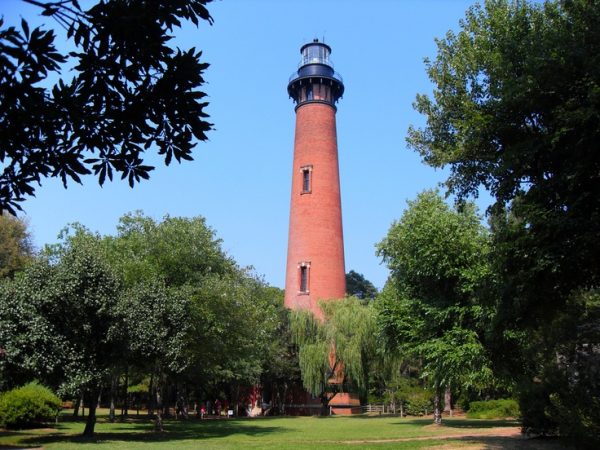Currituck Lighthouse in Corolla, North Carolina offers an impressive view, good history, and is very conveniently located. Highly Recommended!
Currituck Beach Light Station
The Outer Banks of North Carolina is known to have some of the best specimens of lighthouses in close proximity on the Eastern Seaboard of the United States and the Currituck Beach Light Station is no exception. Standing at an impressive 162 feet its bare brick facade stands out prominently on the coast line and makes an excellent visit as long as you don’t mind climbing 214 iron steps! The trip is well worth the view and well worth the history lesson that you learn on your way up the climb.

History and Operation of the Currituck Beach Light Station
First lit on December 1st, 1875 the Currituck Beach Light Station was built approximately 33 miles from the Cape Henry Light and the Bodie Island Lighthouse. Nestled in what is now known as Corolla, North Carolina the lighthouse was built to light the void that neither Cape Henry nor Bodie Island could reach. Construction began in 1873 and the lighthouse needed over 1,000,000 bricks before it was complete.
The base of the lighthouse is nearly 6 feet thick and if you like a good climb each window on your ascension will illustrate the thickness of the lighthouse. Even at the parapet the wall is still 3 feet thick to withstand the torrential winds that the Outer Banks can receive. Visitors can climb up to the observation deck but are not allowed to enter the beacon room since it is still used to this day. The observation deck is well worth the climb. Even on a calm day the breeze is strong and you can imagine what a lighthouse keeper had to go through when a storm was fast approaching.
Originally, the beacon itself was powered by a system of weights that had to be manually cranked every 2 ½ hours. The beacon’s original source of light was five 4 inch wicks fueled by oil that had to be carried up the 214 steps by the lighthouse keeper. The lens is a first-order Fresnel lens which means the lens itself stands over 8 feet tall.
As you can imagine having to hand crank the weights every 2 ½ hours required more than one lighthouse keeper and for the keepers to be very close by. The Keeper’s House was completed in 1876 and sits directly behind the lighthouse. Since the home was a duplex, the senior lighthouse keeper and his family lived on one side while 2 other lighthouse keepers lived on the other side. And since this was 1876 running water next to the ocean was not an available item. The house included 2 louvered cisterns at either end of the house that stored rainwater for the keepers. In 1920 a smaller home from the Long Point Lighthouse Station was moved to Currituck to house the principle keeper and his family. A keeper lived there until 1939 when it was abandoned.
The Decay and Restoration of the Currituck Keeper’s Houses
Once electricity and automation were introduced into lighthouses the keeper position quickly became unnecessary. Trimming the wicks, fueling the lamps, cleaning the lenses was now all automated and electricity kept the light on for ships. The Currituck Station was no different and once the lighthouse became fully automated the property was abandoned and the keeper’s houses quickly succumbed to the elements although the lighthouse itself remained sturdy and in good condition.
By the 1970s the Lighthouse Keepers’ House stood with no windows or doors, most of the interior millwork was vandalized and removed and the 2nd house was so covered with vines and brush that nobody realized it was there until a restoration project began on the Keeper’s House in the 1980s.
The Outer Banks Conservationists, Inc (OBC) is a private non-profit organization dedicated to conserving the character of the Outer Banks and in 1980 they signed a lease with the State of North Carolina to begin a phased restoration of the property.
Visiting Currituck Lighthouse Today
In 1990 the lighthouse was opened to the public and today the grounds and the lighthouse are in well manicured condition. Visitors are welcome daily between Easter and Thanksgiving 9am-5pm and during the summer the lighthouse stays open on Thursdays until 8pm. Even the smaller 2nd house that was so overgrown with vines has been fully restored and is now a souvenir shop. The larger Victorian home has been mostly restored but still has some work to do on the interior before it is fully complete. To date the OBC has raised over $1.5 million of private funds to restore and maintain the grounds.
When you visit the Currituck Lighthouse keep in mind that there were no trees when it was built. No next door neighbors either. There is even still a bit of mystery to the lighthouse. Even the historians can’t place what all the markings and bolts in the lighthouse were used for. So, if you are lucky enough to visit bring your camera, take your time, and ensure to stretch both your legs and your eyes when you reach the top. Currituck will be one for the memories.
